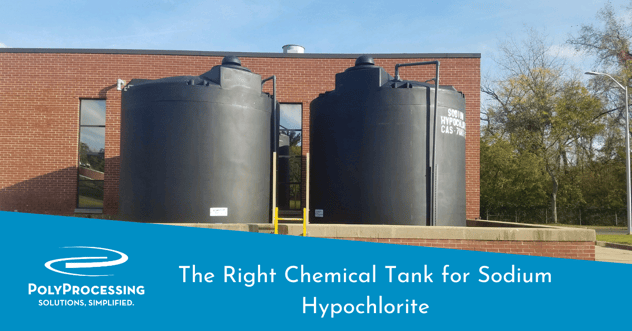The Right Chemical Tank for Sodium Hypochlorite
Sodium hypochlorite, or bleach, is one of the most commonly used chemicals across all industries. But that doesn’t mean you should use a common chemical storage system to contain this aggressive oxidizer. Whether you’re using a bleach concentration of 0.8%, 6%, or 12.5%, sodium hypochlorite will attack your storage tanks more aggressively than most other solutions. Without the proper storage tank system, you could be looking at a tank failure in less time than you expect.

A chemical breach involving sodium hypochlorite can be hazardous to your equipment as well as your employees. But with the right storage system, you can avoid damage while extending the life of your chemical storage tank.
Sodium Hypochlorite Storage Solutions
One of the challenges in storing any oxidative chemical is engineering the tank to not only store the chemical but to give the end user a greater life expectancy and a measure of safety with the tank. It is critical to design the storage tank with the chemical in mind.
Poly Processing works with a leading university to develop engineered polymer systems that will perform above and beyond standard polyethylene in harsh, oxidizing environments. Our OR-1000™ and IMFO® systems are specifically designed to maximize the useful life of the tank storing aggressive oxidizing chemicals like sodium hypochlorite.
Extra Layer of Protection for Extended Useful Life
The OR-1000™ system is designed to maximize the useful life of storage tanks in oxidizing environments. The OR-1000 system consists of engineered resins for these specific applications. This system increases the life of a crosslinked polyethylene tank giving the end user a greater cost effective solution. Poly Processing's crosslinked polyethylene tanks are certified by NSF to store sodium hypochlorite. By producing the tank with the OR-1000 system, we simply want to extend the life of the tank and give the customer the best long term solution available. The OR-1000 system is certified by NSF as well.
The OR-1000 system provides four times the antioxidant power of a standard tank wall, and extends the life of the tank. In one academic study, after 9 months of exposure to sodium hypochlorite, conventional polyethylene became 30 percent more brittle, while the OR-1000 only became three percent more brittle.
Get the details on storing sodium hypochlorite—download our Sodium Hypochlorite Guide.
The Latest Resin Technology
Recently, with the help of a third-party leader in Polymer Engineering, we developed a new and improved OR-1000 resin. We’ve taken what we’ve learned in the field in the last 50 years and improved the material.
This new resin carries other enhancements, including:
- Improvements in the long-term properties: The enhanced resin will in most cases last longer and allow your tank to last longer, too.
- High levels of ESCR: High levels of ESCR (Environmental Stress Crack Resistance) even when storing chemicals such as sodium hypochlorite or peracetic acid.
- Improved elongation: the new OR-1000 will maintain its elongation properties better over time while storing heavy oxidizing chemicals. This performance is superior to other HDPE materials commonly used in tank construction.
Uncompromising Chemical Tank Longevity
The OR-1000 system is an ideal solution to extend the life of your XLPE tank when storing sodium hypochlorite. The technology behind OR-1000 takes the guesswork out of choosing the right storage tank system, and it reduces the risks and maintenance costs of an FRP tank or a high-density polyethylene tank. The value, longevity, strength, and durability of the OR-1000 system can handle almost any chemical and stand the test of time.
For more information on using XLPE and OR-1000 to store corrosive chemicals, download the OR-1000™ Guide.
- April 12, 2021
- Topics: Chemical Storage
About Poly Processing
Posts By Topic
Tech Talk Podcast Episodes
Subscribe By Email
Recent Posts
- Installation Tips for Chemical Storage Tanks: Site Preparation and Offloading
- Understanding pH and Chemical Concentration When Choosing a Chemical Tank
- Maximizing Fill Efficiency: Selecting the Optimal Fill Line System
- Chemical Storage Tanks: A Quick Guide for End Users
- Popular Customization Options for Chemical Storage Tanks
Tank Configurator

Find the recommended tank and system components for your chemical storage challenge.
Configure a Tank Package


